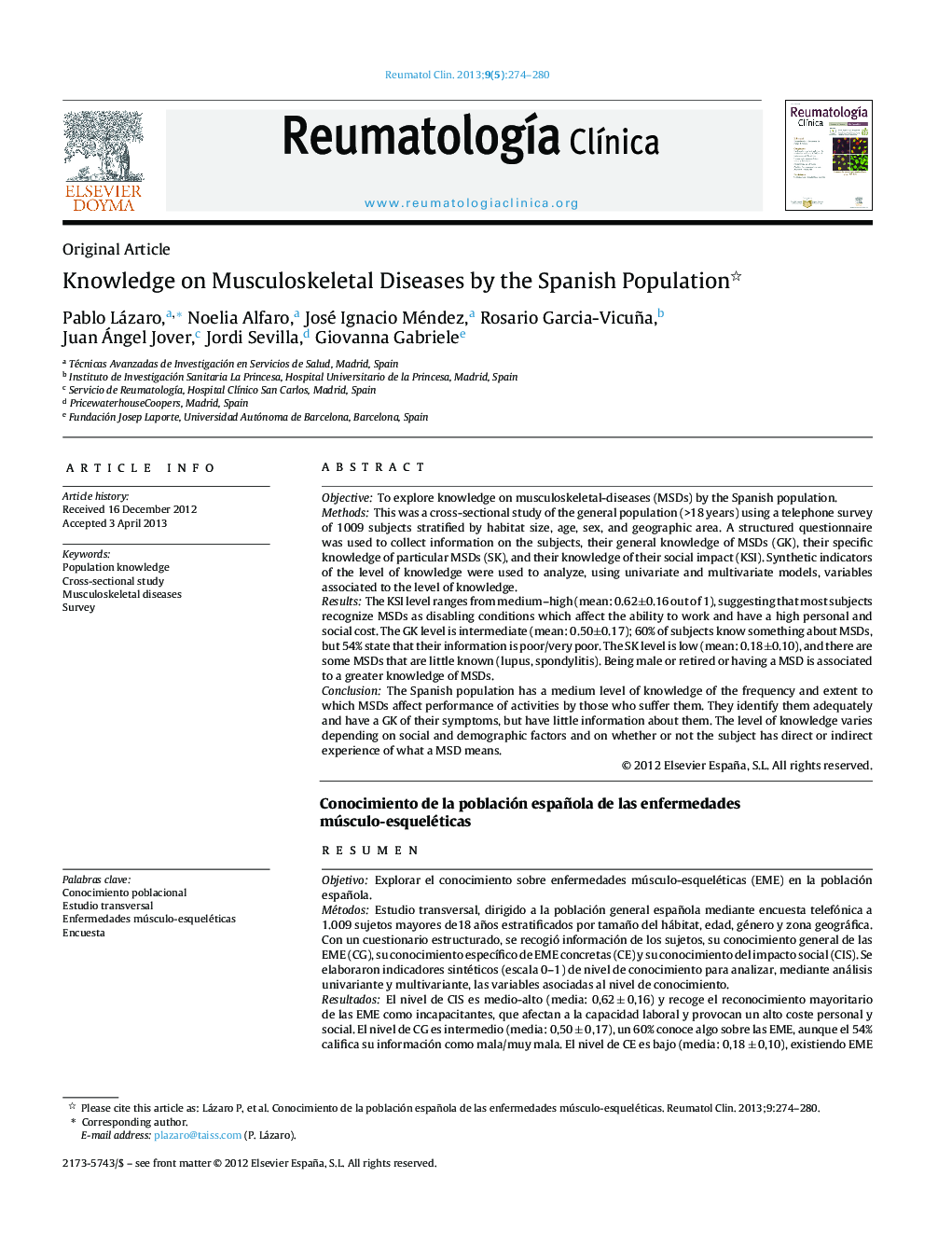| کد مقاله | کد نشریه | سال انتشار | مقاله انگلیسی | نسخه تمام متن |
|---|---|---|---|---|
| 3384387 | 1220526 | 2013 | 7 صفحه PDF | دانلود رایگان |

ObjectiveTo explore knowledge on musculoskeletal-diseases (MSDs) by the Spanish population.MethodsThis was a cross-sectional study of the general population (>18 years) using a telephone survey of 1009 subjects stratified by habitat size, age, sex, and geographic area. A structured questionnaire was used to collect information on the subjects, their general knowledge of MSDs (GK), their specific knowledge of particular MSDs (SK), and their knowledge of their social impact (KSI). Synthetic indicators of the level of knowledge were used to analyze, using univariate and multivariate models, variables associated to the level of knowledge.ResultsThe KSI level ranges from medium–high (mean: 0.62±0.16 out of 1), suggesting that most subjects recognize MSDs as disabling conditions which affect the ability to work and have a high personal and social cost. The GK level is intermediate (mean: 0.50±0.17); 60% of subjects know something about MSDs, but 54% state that their information is poor/very poor. The SK level is low (mean: 0.18±0.10), and there are some MSDs that are little known (lupus, spondylitis). Being male or retired or having a MSD is associated to a greater knowledge of MSDs.ConclusionThe Spanish population has a medium level of knowledge of the frequency and extent to which MSDs affect performance of activities by those who suffer them. They identify them adequately and have a GK of their symptoms, but have little information about them. The level of knowledge varies depending on social and demographic factors and on whether or not the subject has direct or indirect experience of what a MSD means.
ResumenObjetivoExplorar el conocimiento sobre enfermedades músculo-esqueléticas (EME) en la población española.MétodosEstudio transversal, dirigido a la población general española mediante encuesta telefónica a 1.009 sujetos mayores de18 años estratificados por tamaño del hábitat, edad, género y zona geográfica. Con un cuestionario estructurado, se recogió información de los sujetos, su conocimiento general de las EME (CG), su conocimiento específico de EME concretas (CE) y su conocimiento del impacto social (CIS). Se elaboraron indicadores sintéticos (escala 0–1) de nivel de conocimiento para analizar, mediante análisis univariante y multivariante, las variables asociadas al nivel de conocimiento.ResultadosEl nivel de CIS es medio-alto (media: 0,62 ± 0,16) y recoge el reconocimiento mayoritario de las EME como incapacitantes, que afectan a la capacidad laboral y provocan un alto coste personal y social. El nivel de CG es intermedio (media: 0,50 ± 0,17), un 60% conoce algo sobre las EME, aunque el 54% califica su información como mala/muy mala. El nivel de CE es bajo (media: 0,18 ± 0,10), existiendo EME muy poco conocidas (lupus y espondilitis). Ser hombre, jubilado o presentar una EME, se asocia con más conocimiento sobre las EME.ConclusiónLa población española tiene un nivel medio de conocimiento de la frecuencia y medida en que las EME afectan el desempeño de las actividades de quienes las presentan. Las identifican suficientemente, conociendo a grandes rasgos su sintomatología, aunque saben poco de ellas. El nivel de conocimiento varía según los factores sociodemográficos y la experiencia directa e indirecta de presentación de EME.
Journal: Reumatología Clínica (English Edition) - Volume 9, Issue 5, September–October 2013, Pages 274–280